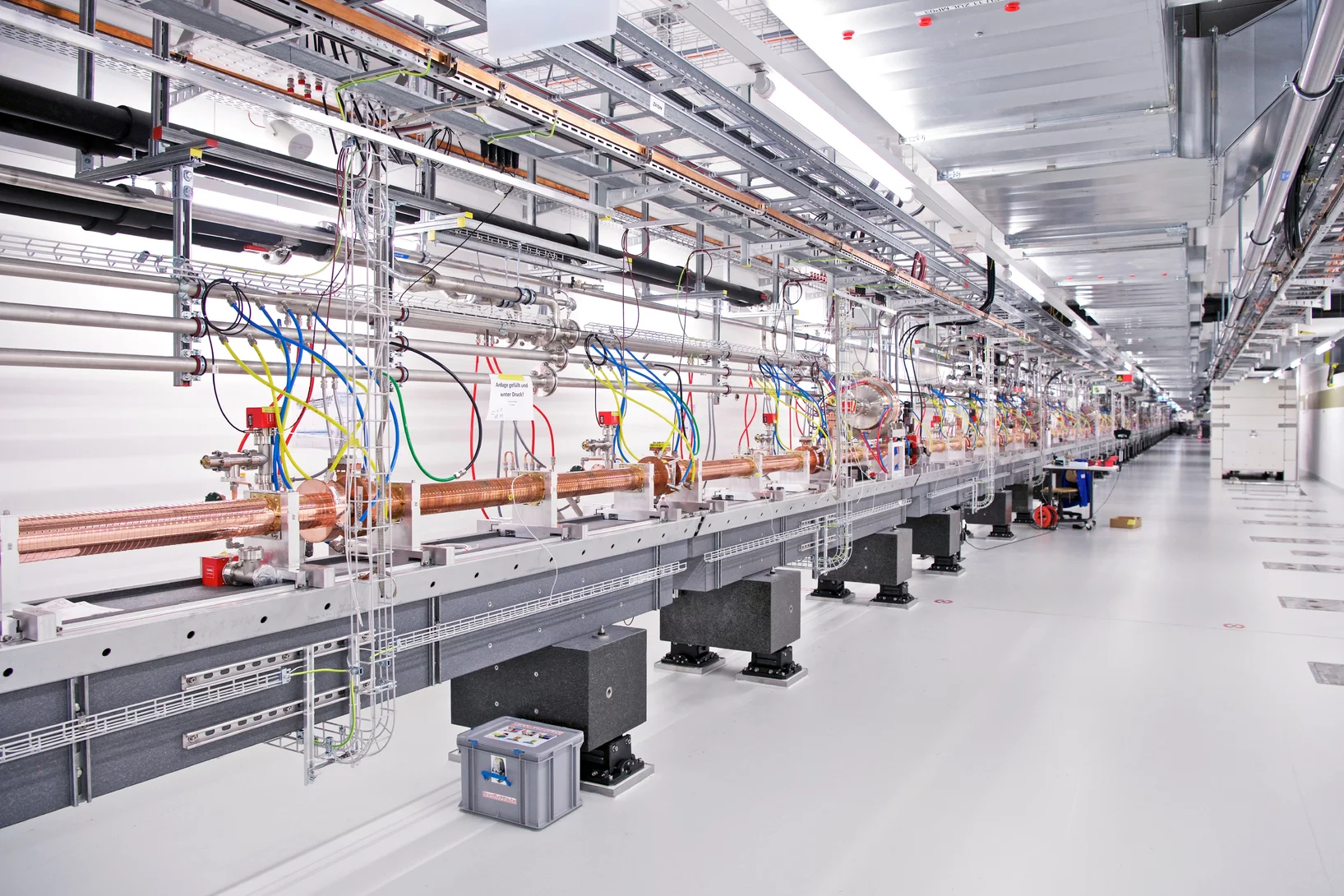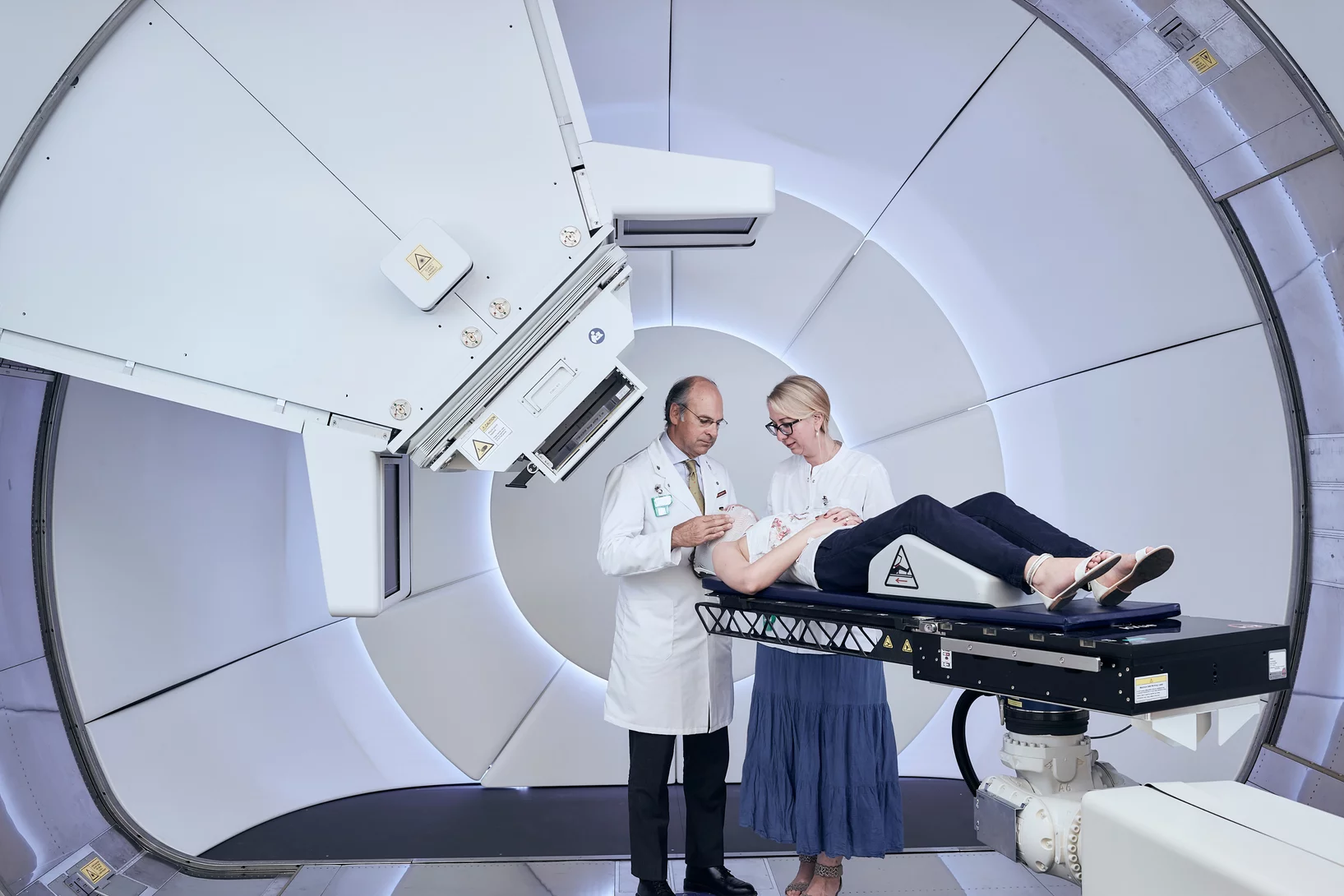Visite publique du Laboratoire Chaud
Découvrez lors de notre visite guidée l’installation nucléaire du Laboratoire Chaud, une installation expérimentale unique en Suisse pour l’étude et l’analyse de matériaux hautement radioactifs dans le domaine de la technologie nucléaire. Une infrastructure bien développée en termes de sécurité, d'analyse et de préparation, ainsi que des laboratoires uniques sont à votre disposition.
Visite publique du SwissFEL
Le SwissFEL est l'une des cinq installations de lasers à rayons X au monde capables de produire des rayons X durs de qualité laser et de les mettre à disposition pour la recherche. Lors de notre visite guidée, nous découvrirons le fonctionnement et les principaux objectifs de recherche de ce laser à rayons X, puis nous ferons une visite pour observer de près les composants clés de l'installation longue de 700 mètres.
Visite publique Protonthérapie
La protonthérapie est une forme de radiothérapie utilisée pour détruire les tissus cancéreux à l'aide de particules chargées, en particulier des protons. Les protons sont particulièrement adaptés à cet usage, car ils délivrent leur effet maximal en profondeur dans le corps, directement dans la tumeur. Au Centre de Protonthérapie du PSI, nous traitons chaque année plus de 400 patients. Lors de notre visite guidée, nous vous présenterons les salles de traitement et expliquerons les contributions du PSI au développement de la protonthérapie.
Die ESA kommt in die Schweiz
Eine Vertragsunterzeichnung zwischen der Europäischen Weltraumorganisation ESA und dem PSI markiert den Start des «European Space Deep-Tech Innovation Centre» ESDI.
Le Laboratoire Chaud a 60 ans
En Suisse, l’installation nucléaire en service depuis le plus longtemps se trouve à l’Institut Paul Scherrer PSI. Elle fête son anniversaire aujourd’hui.
Continuum Excitations in a Spin Supersolid on a Triangular Lattice
Magnetic, thermodynamic, neutron diffraction and inelastic neutron scattering are used to study spin correlations in the easy-axis XXZ triangular lattice magnet K2Co(SeO3)2. Despite the presence of quasi-2D “supersolid” magnetic order, the low-energy excitation spectrum contains no sharp modes and is instead a broad and structured multiparticle continuum. Applying a weak magnetic field ...
S’attaquer à la racine d’un problème de santé global
Imad El Haddad analyse la composition chimique et l’impact sur la santé des particules fines au Center for Energy and Environmental Sciences de l’Institut Paul Scherrer PSI.
Conférence Technologique : IA dans les processus de fabrication
Quand : Jeudi 28 novembre 2024, de 13h30 à 18h00
Où : Paul Scherrer Institut, 5232 Villigen PSI, Auditorium (PSI Ouest)
Inscrivez-vous dès aujourd'hui – nous nous réjouissons de vous accueillir !
Marius Köppel defends his thesis on the Mu3e Data Acqusistion System
Marius Köppel has defended his PhD on the data acquisition system for Mu3e at Johannes Gutenberg University Mainz.
Russell McKenna and Andreas Pautz on Energy Production in Switzerland
“If we exclude individual measures, it just means that we need more of the others.”
Kagome breaks the rules at record breaking temperatures
Discovery of quantum phenomenon at accessible temperatures could be useful for quantum technologies.
Une promesse complexe
Une aviation climatiquement neutre n’implique pas seulement de réduire les émissions des vols. Une étude du PSI analyse ce qui sera nécessaire pour atteindre cet objectif à long terme.
Reentrant multiple-q magnetic order and a “spin meta-cholesteric” phase in Sr3Fe2O7
Topologically nontrivial magnetic structures such as skyrmion lattices are well known in materials lacking lattice inversion symmetry, where antisymmetric exchange interactions are allowed. Only recently, topological multi-q magnetic textures that spontaneously break the chiral symmetry, for example, three-dimensional hedgehog lattices, were discovered in centrosymmetric compounds, where they are instead driven by frustrated interactions. Here we show that ...
PSI am diesjährigen «Open-i»!
Das Open-i ist die führende Schweizer Innovationsplattform und wird am 21. & 22. November in Zürich ausgetragen - das PSI ist als Science Partner mit dabei!
Vers une médecine contrôlée par la lumière
Des scientifiques du PSI ont élucidé la structures de certains photorécepteurs spéciaux.
Julius Springer Price 2024
Prof. Thomas Lippert, Editor in Chief at Applied Physics A, awards Prof. Boris Chichkov the 2024 Julius Springer Prize for Applied Physics.
XRnanotech remporte le Swiss Excellence Product Award 2024
La société XRnanotech AG a remporté le Swiss Excellence Product Award 2024 dans la catégorie PME. Ce spin-off du PSI a été récompensé pour ses développements remarquables dans le domaine des lentilles de Fresnel et des éléments optiques diffractifs (DOE).
Souder sur une grande scène
Ceux qui grimpent sur ce podium font partie des meilleurs talents professionnels du monde. Melvin Deubelbeiss, électronicien au PSI, a remporté la médaille d’argent aux WorldSkills 2024.
Skyrmion topology quantified in 3D
Researchers from an international collaboration between the United States of America and Switzerland have performed three-dimensional magnetic imaging of a magnetic skyrmion using soft X-ray laminography. This allowed for the investigation, in three dimensions, of the topological profile of the magnetic skyrmions.
iLab et SynFuels aux Energy Days ! au Musée Suisse des Transports
18, 19 et 20 octobre 2024
Le iLab de l'Institut Paul Scherrer participera aux Energy Days avec des ateliers passionnants. Découvrez comment nous pouvons stocker l'énergie renouvelable grâce à des technologies innovantes comme le Power-to-Gas et faire avancer la transition énergétique.
Mit dem Fanuc Industrieroboter zum erfolgreichen Bauprojekt
Im Herbst 2023 haben wir einen Fanuc Industrieroboter gekauft. Nach langem Warten wurde dieser am 1. Februar 2024 am PSI angeliefert. Leider musste der Roboter erst noch auf seine ersten Aufgaben warten, da ich zuerst noch meine praktische Abschlussarbeit beenden musste.
Déchiffrer l’énigme des protéines
Cette année, le prix Nobel de chimie est attribué à trois chercheurs qui ont contribué de manière déterminante à déchiffrer le code des protéines, ces importants éléments constitutifs de la vie. Mais pour que des applications puissent être développées à partir de ces connaissances, par exemple dans le domaine médical, des centres de recherche comme le PSI sont indispensables.
Dual-site reaction mechanism for the simultaneous reduction of nitrous and nitric oxides
We have applied three spectroscopic techniques (XAS, EPR and DRIFTS) in combination withe modulated excitation and catalytic data to decipher and propose the complete reaction mechanism of the simultaneous reduction of N2O and NO
Comment les catalyseurs éliminent des oxydes d’azote dangereux
En catalyse industrielle, le fer n'est pas égal au fer.
Lehrlingslager 2024
Dieses Jahr fand das jährliche Lehrlingslager des Paul Scherrer Instituts mit rund 70 Lernenden im Val Calanca statt. Während zwei Wochen arbeiteten die Lernenden in wechselnden Gruppen an vier verschiedenen Baustellen.
Discovery of charge order above roomtemperature in the prototypical kagome superconductor La(Ru1−xFex)3Si2
The kagome lattice is an intriguing and rich platform for discovering, tuning and understanding the diverse phases of quantum matter, crucial for advancing modern and future electronics. Despite considerable efforts, accessing correlated phases at room temperature has been challenging.
Ian Shipsey
The Mu3e collaboration is deeply saddened to by the loss of our colleague and friend Professor Ian Shipsey, Head of Department of Physics in Oxford and co-lead of the Oxford Mu3e group.
Career Perspectives at our Partners: Maria-Alexandra Paun, Federal Office of Communications
Our partners are interested in attracting PSI's early career researchers, and we introduce scientists working at partner companies to showcase career perspectives. In today's post, meet Maria-Alexandra Paun, who did her PhD in Microelectronics and Microsystems at EPFL and is currently working at the Federal Office of Communications. She tells us how she managed the transition away from academia, and what she is working on now.
New Monochromators for SLS 2.0
The brand-new monochromators that have been built by XDS Oxford for the hard X-ray beamlines at SLS 2.0 have now arrived. They were unpacked beginning of the week, and are currently being tested in our new lab space at Park Innovaare. These advanced instruments will play a crucial role in enhancing the beamline performance, ensuring superior precision and efficiency in the upcoming experiments.
Le seigneur des fluides
Lorsqu’il était étudiant, Athanasios Mokos se passionnait déjà pour la dynamique des fluides. Aujourd’hui, il modélise des processus complexes à l’Institut Paul Scherrer PSI, comme la formation de dépôts sur des crayons combustibles dans les réacteurs nucléaires.






























